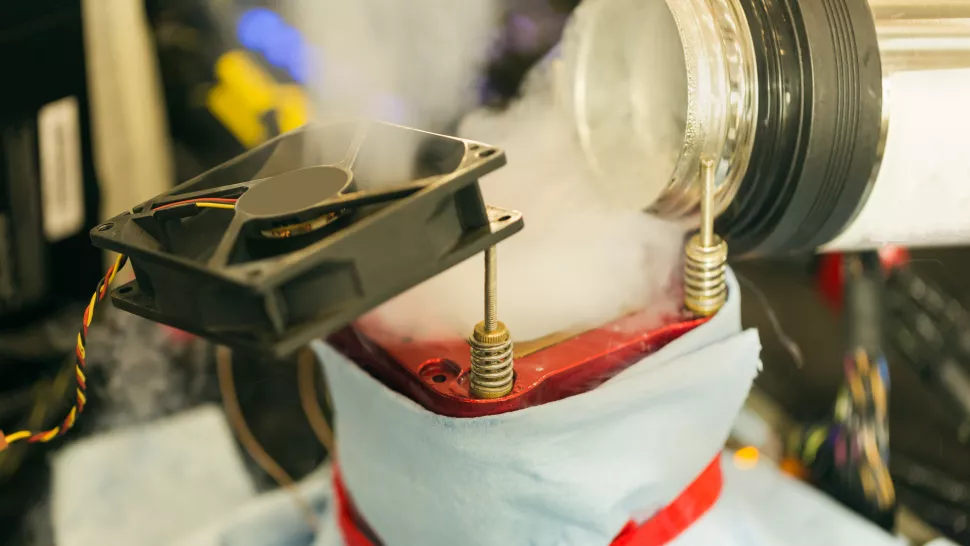CPU-Z Dev Throws Cold Water On Gigabyte's 8 GHz World Record

Twitter user Doc TB, the person who developed the CPU-Z Validator, has debunked Gigabyte's 8 GHz world record with Intel's Core i9-12900K processor. The developer believes that Intel's new flagship Alder Lake likely didn't hit 8 GHz at all.
Extreme overclockers generally use CPU-Z to validate the authenticity of their overclocks. In fact, it's a hard requirement to be able to submit the overclock to HWBot, a popular database that stores benchmark scores and world records. Therefore, the team at CPU-Z was constantly in contact with motherboard manufacturers and in this case with Intel about Alder Lake overclocking.
According to the developer, the team started to see fake overclocks spanning from 8 GHz to 12 GHz on early Alder Lake samples. Apparently, a silicon errata exists with the ratio when set above 63. In some cases, the internal CPU PLL fails to stick, so it remains at the previously configured ratio while still reporting the new one. Although the bug had been discovered prior to launch, it was far too late to push the patch on a silicon level. Furthermore, it's an issue that doesn't affect 99.99% of Intel users.
Even though the problem wasn't meaningful for mainstream users, Intel worked up a fix, anyway. The solution consists of a new microcode update (0x12) through the addition of the HW register called "FLL_OC_MODE." Once enabled and properly configured, the internal CPU ensures that the PLL is appropriately locked with ratios above 63. The CPU-Z team implemented "FLL_OC_MODE" in CPU-Z 1.98. In addition, Doc TB put multiple checks in place with CPU-Z Validator, including microcode version, core throttling, "FLL_OC_MODE" register checking to nullify the submissions that exploited the bug.
Doc TB has since provided some statistics on Alder Lake overclocking. Apparently, 7 GHz on all cores is possible , however, the ceiling for single-core overclocks ranges from 7.5 GHz to 7.6 GHz. As a matter of fact, many processors struggle to get to 7.5 GHz, and overclockers were one-upping each other by a few MHz at best. We're talking about 100+ samples. It certainly raised a red flag when Gigabyte started promoting its 8 GHz overclock on social media and in a press release.
HiCookie, Gigabyte's in-house overclocker, validated the 8 GHz overclock on November 3 utilizing CPU-Z 1.98, which already has the "FLL_OC_MODE" implementation. It seems to tick all the boxes, but the fact that the overclocker didn't submit the result to HWBot looks pretty suspicious. Even if the result looks legit, Doc TB can think of a way how you could bypass Intel's fix if you were to have access to the BIOS source code, which many overclockers that work with motherboard vendors do.
The hypothetical workaround consists of altering the CPU ratio and subsequently upgrading the microcode to enable "FLL_OC_MODE" during boot. While the check is enabled, the processor is clocked at a lower ratio then the value reported. This isn't something that happens out of the blue, either. It involves intentional tampering. If the PLL isn't locked down, the processor will go into a hard-lock instantly. Thus, a system reboot is required. Sadly, it's not an algorithm that the team can slip into CPU-Z since Windows crashes are reported to Microsoft's telemetry, and Windows Defender can put CPU-Z on the blacklist for that.
The CPU-Z team has its hands tied, and therefore, only Intel can solve the problem through either a new hardware stepping or another microcode patch. Admittedly, Intel probably won't waste further resources just to fix a bug to provide a level playing field for overclockers. If Gigabyte's overclock ends up having been a PR stunt, it'll not only hurt the company's credibility, but also tarnish HiCookie's (who is one of the more respected personalities in the extreme overclocking scene) reputation.